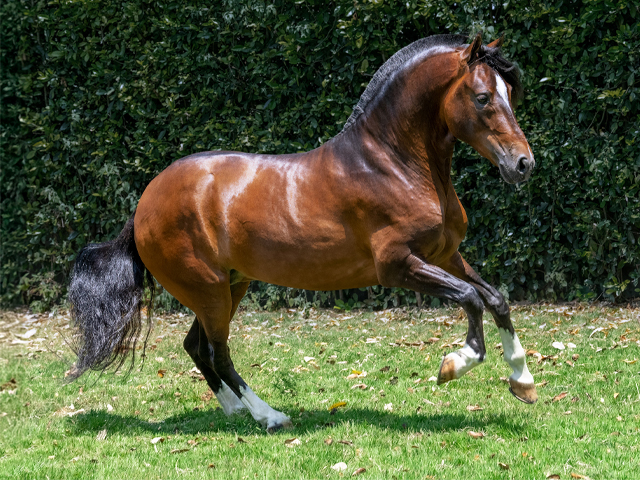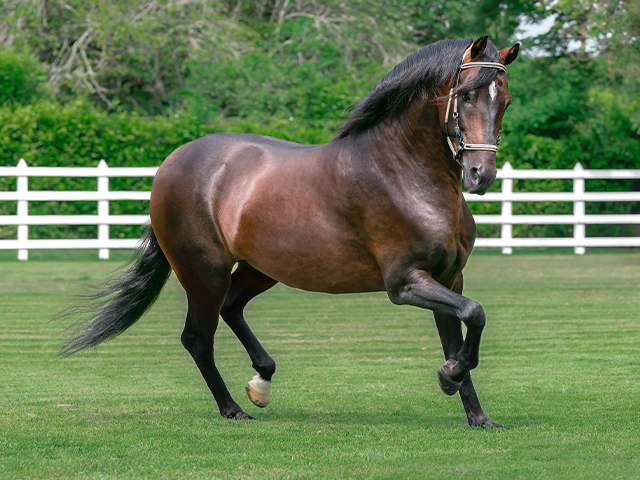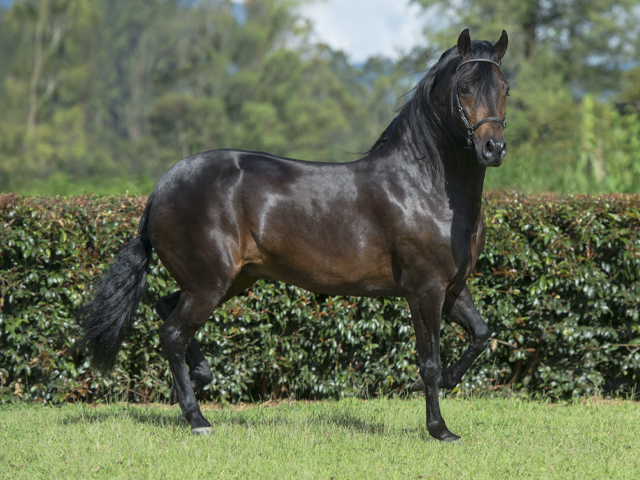Colombian Trote and Galope
DIAGONALS P1
Colombian Trocha and Galope
DIAGONALS P2
Colombian Trocha
DIAGONALS P3
Paso Fino
LATERALS P4
Colombian Trote and Galope
⸻ DIAGONALS P1

Definición: Trote is the way of movement of some of our equines through the successive and alternated movement of its two diagonal bipeds, producing one beat with each biped, performing the complete cycle in two beats, without suspension, in none of them.
Su sonido característico es tas… tas… tas… tas…
Definition of Galope: Galope is a diagonal sequence gait in three beats, which’s cycle or complete gait starts the horse in a first beat with one of its legs, continues in a second beat with the diagonal formed by the other leg and its diagonal hand, and ends in a third beat with the hand diagonal to the leg with which the first beat was made.
Its characteristic sound is es ca… tor… ce… ca… tor… ce… ca… tor… ce…
The fundamental characteristics of the Trote and Galope horse are its collection in movement and the total absence of in both gaits. The former, plus its biro, reins and elasticity of hocks makes it in the world, one of the smoothest for the saddle in this gait.
Phenotype
Height
Minimun for Stallions 1.35 meters
Minimun for Mares 1.34 meters
Under the minimum stablished height the horses will be disqualified by Regulation.
Plumb
Like vertical lines that the moving members must follow, they must be analyzed in motion and standing, with frontal, rear and lateral inspection. Regarding the back legs, it is established that they can separately attach to “The vertical lines from the top of the croup”. The moving members must have total anatomic and physiologic normality.
Movements
Previous train: elastic, of medium height and linear propulsion in Trote. Slightly higher in back legs than in front legs when in Galope.
Rear train:elastic linear propulsion, medium height and flat step in Trote and in Galope.
Harmony and softness
Harmony: All parts must contribute to the virtual and sound balance of the movement.
Softness: It should offer maximum comfort when riding.
Execution and sustainment
Execution Slow cadence for trotting. Slow cadence for the gallop. Movement combined in both gaits and without losing the ground in any of its times (without suspension).
Sustainment You must keep the rhythm perfectly.
Brío and temperament
Brío: You must respond positively to the demands made by the driver while driving.
Temperament Noble and voluntary.

Harmony and Perfection for the different body parts.
Head
Profile: Rectilinear (Ideal).
Face: Emaciated, short and wide.
Eyes: Separate and alive, in broad forehead.
Nostrils: Large and dilatable.
Ears: Medium sized, narrow; mobile and parallel.
Neck and mane
Neck: Triangular in shape with a wide base. Arched on the top line and straight on the bottom. Strong. Rather short in length and depth. With soft inserts to head and trunk.
Mane: Preferably a motilón with an arched valance. When the mane is left long, it is proportional, silky and soft.
Withers: Slightly tall.
Back: Muscular With an angle to the ground of more or less 51 degrees and angle
Scapule-90 Degree Humeral, which can reach up to 92 Degrees.
Rib cage: A little concave. Strong. Of medium length and ample muscles.
Chest: Wide, deep and muscular.
Belly:Deep, strong and wide.
Croup: Round and wide. Muscled and medium length.
Tail:Set slightly high. With long and slim dock. Elegant posture and abundant and silky hair volume.
Hooves:Medium sized, but proportioned to the body.
Skin: Skinny, pigmented with short hair.
Color: Defined.
Extremities and pasterns
Extremities - Muscled, of thin and clean bones, strong joints.
Pasterns: Medium sized, strong and flexible, with an angle to the floor of about 53 degrees in the front legs and 55 degrees in the back legs. Its front profile should forma a straight line with the hooves.
Training and rein
Easy to drive and handle. You must choose precisely the indicated time of change when the chalan tells you that he wants to change from trot to canter, and return with equal precision.
Colombian Trocha and Galope
⸻ DIAGONALS P2

Definición:
It is the way of movement of some of our equines with a successive and alternated move of its two diagonal bipeds, producing two beats with each biped, to execute the complete cycle.
Its characterized sound is tras… tras… tras… tras…
Definition of Galope: Galope is a diagonal sequence gait in three beats, which’s cycle or complete gait starts the horse in a first beat with one of its legs, continues in a second beat with the diagonal formed by the other leg and its diagonal hand, and ends in a third beat with the hand diagonal to the leg with which the first beat was made.
Its characteristic sound is es ca… tor… ce… ca… tor… ce… ca… tor… ce…
The fundamental characteristics of the Trote and Galope horse are its collection in movement and the total absence of in both gaits. The former, plus its biro, reins and elasticity of hocks makes it in the world, one of the smoothest for the saddle in this gait.
Phenotype
Height
Minimun for Stallions 1.35 meters
Minimun for Mares 1.34 meters
Under the minimum stablished height the horses will be disqualified by Regulation.
Plumb
Like vertical lines that the moving members must follow, they must be analyzed in motion and standing, with frontal, rear and lateral inspection. Regarding the back legs, it is established that they can separately attach to “The vertical lines from the top of the croup”. The moving members must have total anatomic and physiologic normality.
Movements
Previous train: elastic, of medium height and linear propulsion in Trote. Slightly higher in back legs than in front legs when in Galope.
Rear train:elastic linear propulsion, medium height and flat step in Trote and in Galope.
Harmony and softness
Harmony: All parts must contribute to the virtual and sound balance of the movement.
Softness: It should offer maximum comfort when riding.
Execution and sustainment
Execution Slow cadence for trotting. Slow cadence for the gallop. Movement combined in both gaits and without losing the ground in any of its times (without suspension).
Sustainment You must keep the rhythm perfectly.
Brío and temperament
Brío: You must respond positively to the demands made by the driver while driving.
Temperament Noble and voluntary.

Harmony and Perfection for the different body parts.
Head
Profile: Rectilinear (Ideal).
Face: Emaciated, short and wide.
Eyes: Separate and alive, in broad forehead.
Nostrils: Large and dilatable.
Ears: Medium sized, narrow; mobile and parallel.
Neck and mane
Neck: Triangular in shape with a wide base. Arched on the top line and straight on the bottom. Strong. Rather short in length and depth. With soft inserts to head and trunk.
Mane: Preferably a motilón with an arched valance. When the mane is left long, it is proportional, silky and soft.
Withers: Slightly tall.
Back: Muscular With an angle to the ground of more or less 51 degrees and angle
Scapule-90 Degree Humeral, which can reach up to 92 Degrees.
Rib cage: A little concave. Strong. Of medium length and ample muscles.
Chest: Wide, deep and muscular.
Belly:Deep, strong and wide.
Croup: Round and wide. Muscled and medium length.
Tail:Set slightly high. With long and slim dock. Elegant posture and abundant and silky hair volume.
Hooves:Medium sized, but proportioned to the body.
Skin: Skinny, pigmented with short hair.
Color: Defined.
Extremities and pasterns
Extremities - Muscled, of thin and clean bones, strong joints.
Pasterns: Medium sized, strong and flexible, with an angle to the floor of about 53 degrees in the front legs and 55 degrees in the back legs. Its front profile should forma a straight line with the hooves.
Training and rein
Easy to drive and handle. You must choose precisely the indicated time of change when the chalan tells you that he wants to change from trot to canter, and return with equal precision.
Colombian Trocha
⸻ DIAGONALS P3

Definición: It is the way of movement of some of our equines with a successive and alternated move of its two diagonal bipeds, producing two beats with each biped, to execute the complete cycle.
Its characterized sound is tras… tras… tras… tras…
Phenotype
Height
Minimun for Stallions 1.34 meters
Minimun for Mares 1.32 meters
Under the minimum stablished height the horses will be disqualified by Regulation.
Plumb
Like vertical lines that the moving members must follow, they must be analyzed in motion and standing, with frontal, rear and lateral inspection. Regarding the back legs, it is established that they can separately attach to “The vertical lines from the top of the croup”. The moving members must have total anatomic and physiologic normality.
Perfección y armonía en las diferentes partes del cuerpo
Movements
Previous train: elastic; medium lift and linear advance; with the same elevation as the later one. The tread must be flat.
Tren posterior: elastic, medium height and linear propulsion, flat step.
Harmony and softness
Harmony: All parts must contribute to the virtual and sound balance of the movement.
Softness: It should offer maximum comfort when riding.
Execution and sustainment
Execution With very fast cadence and energy in the rhythm.
Sustainment You must maintain the rhythm perfectly on both soft and hard floors.
Brío and temperament
Brío: You must respond positively to the driver's demands while driving.
Temperament Noble and voluntary.
Training and rein Easy to drive and handle.

Harmony and Perfection for the different body parts.
Head
Profile: Rectilinear (Ideal).
Face: Emaciated, short and wide.
Eyes: Separate and alive, in broad forehead.
Nostrils: Large and dilatable.
Ears: Medianas, angostas; móviles y paralelas.
Neck and mane
Neck: Triangular form with a wide base. Arched in its upper portion and straight in the lower portion. Strong. Joining softly into head and body.
Mane: Not very abundant, silky and soft.
Withers: Slightly tall.
Back: Muscled. With angle to the floor of about 53 degrees and Scapula- Humeral angle of 90 degrees up to 92 degrees.
Escápulo: 90 Degree Humeral, which can reach up to 92 Degrees.
Rib cage: Slightly concave. Strong. Mid length and wide muscles.
Chest: Wide, deep and muscular.
Belly: Deep, strong and wide.
Croup: Round and wide. Muscled and medium length.
Tail: Set slightly high. With long and slim dock. Elegant posture and abundant and silky hair volume.
Hooves: Medium sized, but proportioned to the body.
Skin: Skinny, pigmented with short hair.
Color: Defined.
Extremities and pasterns
Extremities - Muscled, of thin and clean bones, strong joints.
Pasterns: Medium sized, strong and flexible, with an angle to the floor of about 53 degrees in the front legs and 55 degrees in the back legs. Its front profile should forma a straight line with the hooves.
PASO FINO
⸻ LATERALS P4 ⸻

Definición: Paso Fino is a gait or walk executed by some of our equines, characterized by an alternated and successive displacement of its two lateral bipeds, producing two beats with each biped to execute the complete cycle or gait in four beats.
Its characterized sound is ta…ca…ta…ca…ta…ca…ta…ca…
The feature that gives it maximum quality is the finesse, product of a permanent and strange synchronism between the speed of the rhythm and the magnitude of displacement. This particularity maintains at all times the beats isochronism, which is verified on hard surface by its sameness sound and on soft surface by the feeling of the rider, when it forms with the horse a true binomial.
It was during his second voyage to the New World when Christopher Columbus brought the first horses to Santo Domingo (Dominican Republic today). Those animals were mestizos Barbas, Berber and Andalusian of Spain. Later in Mexico and South America, other races will join them, but his complete isolation will recognize them as the ancestors of the Paso Fino.
The offspring of the horses were blasted by the countries discovered by explorers and attacked by the invaders. The horses were used as means of transportation to Puerto Rico and Colombia, the Isthmus of Panama and Mexico, and Cuba.
Phenotype
Height
Minimun for Stallions 1.34 meters
Minimun for Mares 1.32 meters
Under the minimum stablished height the horses will be disqualified by Regulation.
Plumb
Like vertical lines that the moving members must follow, they must be analyzed in motion and standing, with frontal, rear and lateral inspection. Regarding the back legs, it is established that they can separately attach to “The vertical lines from the top of the croup”. The moving members must have total anatomic and physiologic normality.
Movements
Previous train: elastic; medium lift and linear advance; with the same elevation as the later one. The tread must be flat.
Tren posterior: elastic, medium height and linear propulsion, flat step.
Harmony and softness
Harmony: All parts must contribute to the virtual and sound balance of the movement.
Softness: It should offer maximum comfort when riding.
Execution and sustainment
Execution With very fast cadence and energy in the rhythm.
Sustainment You must maintain the rhythm perfectly on both soft and hard floors.
Brío and temperament
Brío: You must respond positively to the driver's demands while driving.
Temperament Noble and voluntary.
Training and rein Easy to drive and handle.

Harmony and Perfection for the different body parts.
Head
Profile: Rectilinear (Ideal).
Face: Emaciated, short and wide.
Eyes: Separate and alive, in broad forehead.
Nostrils: Large and dilatable.
Ears: Medianas, angostas; móviles y paralelas.
Neck and mane
Neck: Triangular form with a wide base. Arched in its upper portion and straight in the lower portion. Strong. Joining softly into head and body.
Mane: Not very abundant, silky and soft.
Withers: Slightly tall.
Back: Muscled. With angle to the floor of about 53 degrees and Scapula- Humeral angle of 90 degrees up to 92 degrees.
Escápulo: 90 Degree Humeral, which can reach up to 92 Degrees.
Rib cage: Slightly concave. Strong. Mid length and wide muscles.
Chest: Wide, deep and muscular.
Belly: Deep, strong and wide.
Croup: Round and wide. Muscled and medium length.
Tail: Set slightly high. With long and slim dock. Elegant posture and abundant and silky hair volume.
Hooves: Medium sized, but proportioned to the body.
Skin: Skinny, pigmented with short hair.
Color: Defined.
Extremities and pasterns
Extremities - Muscled, of thin and clean bones, strong joints.
Pasterns: Medium sized, strong and flexible, with an angle to the floor of about 53 degrees in the front legs and 55 degrees in the back legs. Its front profile should forma a straight line with the hooves.

